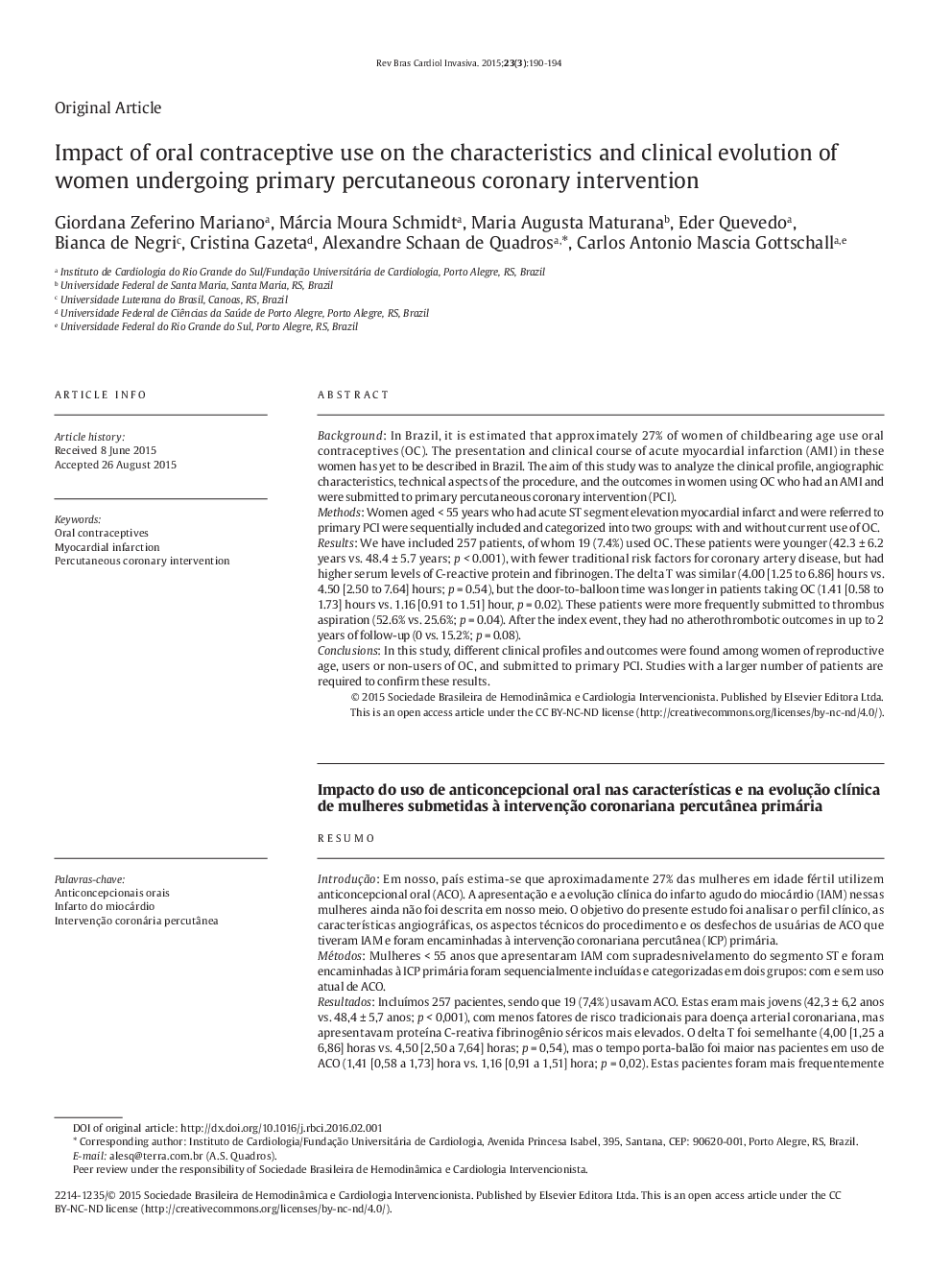| Article ID | Journal | Published Year | Pages | File Type |
|---|---|---|---|---|
| 3011675 | Revista Brasileira de Cardiologia Invasiva (English Edition) | 2015 | 5 Pages |
ABSTRACTBackgroundIn Brazil, it is estimated that approximately 27% of women of childbearing age use oral contraceptives (OC). The presentation and clinical course of acute myocardial infarction (AMI) in these women has yet to be described in Brazil. The aim of this study was to analyze the clinical profile, angiographic characteristics, technical aspects of the procedure, and the outcomes in women using OC who had an AMI and were submitted to primary percutaneous coronary intervention (PCI).MethodsWomen aged < 55 years who had acute ST segment elevation myocardial infarct and were referred to primary PCI were sequentially included and categorized into two groups: with and without current use of OC.ResultsWe have included 257 patients, of whom 19 (7.4%) used OC. These patients were younger (42.3 ± 6.2 years vs. 48.4 ± 5.7 years; p < 0.001), with fewer traditional risk factors for coronary artery disease, but had higher serum levels of C-reactive protein and fibrinogen. The delta T was similar (4.00 [1.25 to 6.86] hours vs. 4.50 [2.50 to 7.64] hours; p = 0.54), but the door-to-balloon time was longer in patients taking OC (1.41 [0.58 to 1.73] hours vs. 1.16 [0.91 to 1.51] hour, p = 0.02). These patients were more frequently submitted to thrombus aspiration (52.6% vs. 25.6%; p = 0.04). After the index event, they had no atherothrombotic outcomes in up to 2 years of follow-up (0 vs. 15.2%; p = 0.08).ConclusionsIn this study, different clinical profiles and outcomes were found among women of reproductive age, users or non-users of OC, and submitted to primary PCI. Studies with a larger number of patients are required to confirm these results.
RESUMOIntroduçãoEm nosso, país estima-se que aproximadamente 27% das mulheres em idade fértil utilizem anticoncepcional oral (ACO). A apresentação e a evolução clínica do infarto agudo do miocárdio (IAM) nessas mulheres ainda não foi descrita em nosso meio. O objetivo do presente estudo foi analisar o perfil clínico, as características angiográficas, os aspectos técnicos do procedimento e os desfechos de usuárias de ACO que tiveram IAM e foram encaminhadas à intervenção coronariana percutânea (ICP) primária.MétodosMulheres < 55 anos que apresentaram IAM com supradesnivelamento do segmento ST e foram encaminhadas à ICP primária foram sequencialmente incluídas e categorizadas em dois grupos: com e sem uso atual de ACO.ResultadosIncluímos 257 pacientes, sendo que 19 (7,4%) usavam ACO. Estas eram mais jovens (42,3 ± 6,2 anos vs. 48,4 ± 5,7 anos; p < 0,001), com menos fatores de risco tradicionais para doença arterial coronariana, mas apresentavam proteína C-reativa fibrinogênio séricos mais elevados. O delta T foi semelhante (4,00 [1,25 a 6,86] horas vs. 4,50 [2,50 a 7,64] horas; p = 0,54), mas o tempo porta-balão foi maior nas pacientes em uso de ACO (1,41 [0,58 a 1,73] hora vs. 1,16 [0,91 a 1,51] hora; p = 0,02). Estas pacientes foram mais frequentemente submetidas à tromboaspiração (52,6% vs. 25,6%; p = 0,04). Após o evento índice, elas não apresentaram desfechos aterotrombóticos em até 2 anos de acompanhamento (0 vs. 15,2%; p = 0,08).ConclusõesNeste estudo, encontramos perfil clínico e desfechos diferentes entre mulheres em idade reprodutiva, usuárias ou não de ACO, e submetidas à ICP primária. Estudos com maior número de pacientes são necessários para confirmar tais resultados.
